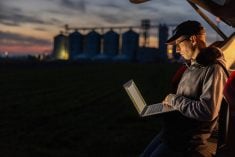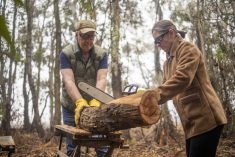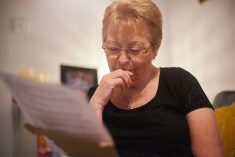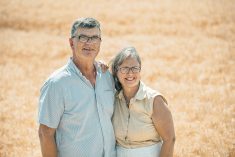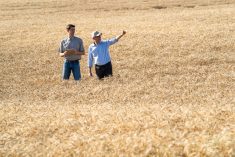A single father — let’s call him Dave — is in his mid-60s. He lives in south-central Manitoba. Dave inherited several quarters of choice potato land from his parents upon their passing. Over the years he has sold of a couple of quarters but still has two quarters remaining. Dave has three kids, and he wants his eventual estate to be distributed as equally as possible — ideally, with a third of everything going to each child.
Two of Dave’s kids live in Canada; however, one child went to school in the U.S., now lives and works there full-time and is considered a U.S. resident for tax purposes, and must file U.S. 1040 tax returns. If all children were resident in Canada, estate distribution would be straightforward. However, having a U.S. resident heir adds some complexity.
Dave approached financial planners Nathan Heppner and Erik Forbes of Forbes Wealth Management at Carberry, Man. to review his situation and to start developing an estate distribution plan.
Read Also

Gentle treatments for pain in the neck
Heading toward year-end, people unknowingly tense up against the cold and busyness, causing neck pain that can often be treated with appropriate support and gentle mobility, athletic therapist Kathlyn Hossack says.
Aside from the potato land, worth $3 million, Dave has roughly $1.5 million of personal assets — cash, TFSAs, RRSP, non-registered financial assets and the primary residence, Forbes explains. There are no substantial debts. Dave’s goal is to distribute his estate equally, making it easy on the executor without any adverse tax consequences to his estate or the heirs. Part of that was also to ensure the kids received the land, as he didn’t want his estate to be forced to sell it. Dave also wants to ensure the heirs would be able to utilize their own lifetime capital gains exemptions.
Dave’s secondary goal is to manage taxable income, because in some years his taxable income is high. That can cause all his Old Age Security (OAS) to be clawed back.
Nathan and Erik presented Dave with four alternatives:
- distribute all assets equally among the kids,
- allocate land to Canadian residents and other assets to U.S. residents,
- utilize a trust, or
- incorporate.
Distribute all assets equally
This strategy could be carried out either during Dave’s lifetime or, upon his passing, through his estate where it would be governed by his will. In Manitoba there is no probate fee, so this is no concern. The only benefit of passing the land on now would be to ensure Dave qualifies for OAS. However, he would be relinquishing control of the land, and it could be exposed to creditors or estranged spouses of his kids. If he decides to go this route, he should take back a zero per cent interest promissory note to protect his interest in the land. A slightly better alternative would be to have the assets distributed only upon his passing. This would ensure ownership is maintained and sufficient income through retirement. However, it won’t help Dave qualify for OAS.
Distributing assets now or through the estate would also give rise to potentially complex cross-border tax issues if the U.S. resident child inherits the land directly. It could lead to adverse tax consequences, increased reporting requirements and additional costs.
Land to Canadians, other assets to non-residents
This is much like the distribution outlined above through the estate; however, rather than all assets being distributed proportionately, it would see land go to the Canadian resident children and all other assets flow to the U.S. resident child. If the Canadian resident children are receiving the farmland, their inheritance will be $1.5 million each in today’s dollars. The remaining $1.5 million could be given to the U.S. resident child. Nevertheless, some of it, such as RRSPs and taxable margin accounts, would be taxable, Heppner notes.
The tax bill to Dave’s estate will likely be minimal, because the farmland can be passed to the next generation at any value between book value and market value. The TFSAs and principal residence are not taxable. As with under option one, the land could be distributed now; however, in addition to the concerns mentioned earlier, there is the added issue that heirs would receive their inheritances at separate times. If the land is distributed now to the Canadian resident children, it could be many years before other assets are distributed to the U.S. resident child. Furthermore, the non-farm assets will likely be used to support Dave’s lifestyle, dwindling the U.S. child’s inheritance. Depending on Dave’s health, he could look at using insurance to equalize the estate. However, Dave is a smoker, so insurance premiums are a prohibiting factor.
Roll land into a trust
By rolling the assets — specifically the farmland — into a trust, Dave would technically relinquish ownership of the assets to the trust. There are some added benefits to this: income flexibility, ensuring use of the beneficiaries’ lifetime capital gains exemption(s), and the ability to change your mind on who inherits what. Also, if the children are resident in Canada, using the lifetime capital gains exemption should not be an issue, whether a trust is used or not.
In Canada there is what is known as the 21-year trust rule. This means that at the end of the 21st year from trust inception or previous taxation under the rule, all assets are deemed to be sold and any taxes become payable. The way around this is to have the assets distributed to the beneficiaries prior to the end of the 21st year. This may not be ideal, because there is a good chance Dave could live longer than 21 years.
Although there are some benefits to implementing the trust, it is not without its drawbacks. Having a trust adds another layer of complexity and administrative cost to the situation. Trusts can also be costly to set up and have ongoing reporting and filing requirements. Any income retained in the trust is also taxed at the highest marginal rate. This means all income from the land will have to be paid out each year. Not to mention, putting a trust in place still doesn’t solve our cross-border issues and potentially opens the door to other potential tax and legal issues and added complexity on the U.S. side.
Incorporate
Rolling the land into a corporation would serve a similar purpose to rolling the land into a trust but would be less costly. The land could be rolled into the corporation and no taxes would be payable. This alternative would allow Dave to use any remaining lifetime capital gains exemption. This would also allow Dave to have more control of his income, as unneeded income could be left in the corporation, Heppner adds.
This strategy doesn’t necessarily solve the estate distribution concerns, and it brings about other potential issues. Although the shares could be passed down to the heirs, there is the potential concern that the shares would not qualify for this treatment. The shares would have to be in an active farming business.
This would depend on the income that the corporation earns along with its assets. Furthermore, once the land is in the corporation, it can become very difficult and expensive to get it out. Like the trust structure, this still doesn’t solve our cross-border concerns. If the U.S. resident child were to inherit shares, there could be adverse tax consequences. Specialized cross-border tax advice would be advisable, Forbes suggests.
In the end, sometimes the best solution is to not overcomplicate things unnecessarily. In this situation, Nathan and Erik suggest Dave keep things simple by recommending a mix of option 1 and 2 — that is, have the assets distributed through the estate. If the child still resides in the U.S., all the non-farming assets would pass to him. However, if all children are resident in Canada upon Dave’s passing, everything can be distributed equally.
This involves having a very clearly defined will. Due to the cross-border nature, and the potential for family situations to change significantly, it would be prudent for Dave to review his will every five years, or as circumstances dictate.



